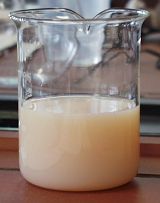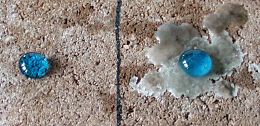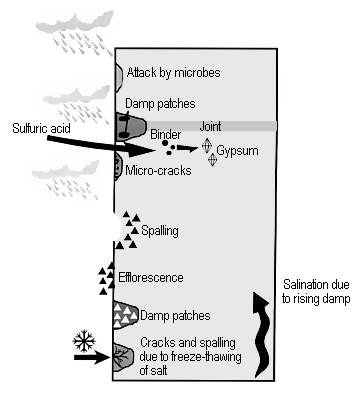 |
Silicones in Masonry Protection |
 |
  1
Materials, Chemicals, Time Needed 1
Materials, Chemicals, Time Needed |
 |
- Dropping pipet
- Aerated concrete brick
- Flower pot (fired
clay)
- Piece of concrete
- Candle
- Glass beaker
It takes
about 5 minutes to impregnate each building material. Roughly
one day is needed for the building
materials to dry.
|
 |
  2
Procedure and Observations 2
Procedure and Observations |
 |
First
of all, prepare fresh microemulsion. Add 100 to 200 ml
of water to the glass beaker and stir in 1/10th as much
(by weight) microemulsion SILRES® SMK
1311.
A yellowish
white emulsion forms (photo right).
This emulsion can
be used to impregnate, for example, the aerated concrete
brick provided in WACKER's Experimental Kit,
a small flower pot or a piece of concrete.
To do this, dip half of the object in the emulsion
for 5 minutes. Allow the dipped objects to dry in air
for
about a day. Additionally, rub a candle over part of
the piece
of concrete to impregnate it with paraffin wax.
|
 |
 |
|
 |
|
 |
|
The
same effect is observed on the concrete covered with
paraffin wax. The untreated surfaces, however, absorb
the water. Note also that the paraffin wax impregnation
can be scratched off, and the water-repellent effect
is lost as a result.
In contrast, the silicone layer cannot be scratched
off, and so the water repellence is retained. |
| Water droplet on concrete treated
with silicone (left) and paraffin wax (right) |
|
|
 |
 |
 |
|
|
 |
  3
Discussion of Results 3
Discussion of Results
|
 |
The microemulsion used contains
tiny silicone particles dispersed in water. The particles have
a diameter of approx. 10-6 cm.
The small particle size allows the silicone to penetrate far
into the building material. When the building material dries,
the water evaporates and leaves a water-repellent silicone layer
behind.
Paraffin wax is also highly water-repellent. Paraffin waxes generally
do not spread as well as silicones and have a higher surface
tension that prevents them from penetrating as deeply into the
building material. Unlike silicone molecules, paraffin wax molecules
consist exclusively of hydrophobic parts and cannot interact
as effectively with the surface of the inorganic building materials
(see also experiment "Hydrophobic
properties of silicone fluids").
In the case of the untreated surfaces, the water readily penetrates
into the building material, where it is stored in the pores. |
 |
  4
Tips and Comments 4
Tips and Comments
|
 |
- Color the water droplet with methylene blue
dye to accentuate the contours of the water droplet and
to make observations
easier.
- The impregnated surfaces can be kept for years for demonstration
purposes.
- The emulsion solution is only stable for about 24 hours.
After that, it starts to lose its effectiveness.
|
 |
This experiment is ideal for
demonstrating the relationship between the properties of a
material and the structure of its particles (here: interactions
between particles as the cause of hydrophobicity and hydrophilicity).
It also provides a gateway for discussing microemulsions.
The experiment is highly relevant to everyday life. In chemistry
classes, it is best to first perform the experiment "Hydrophobic
properties of silicone fluids" as a way of discovering the
water-repellent properties of silicones and then to perform this
experiment on aerated concrete in order to demonstrate a practical
application of the knowledge gained. The two experiments could
be conducted by groups of pupils working according to the group
learning method. |
 |
  5
Supplementary Information 5
Supplementary Information
|
 |
| Moisture is one of the most critical
problems confronting planners, builders and house owners trying
to protect buildings effectively. Most silicate-based building
materials, such as concrete, clay and cement are porous to a
certain degree. |
| They therefore
have a relatively high thermal insulation value and enable
the exchange of gases to take place that is necessary for
a healthy living environment. When the
building materials absorb water, the pores become filled
with water and the thermal insulation properties break
down. The water may be absorbed in liquid form (rain water,
vadose water etc) and as vapor (condensation in capillaries
etc). Persistent wetting causes water damage to the building
materials, which can be seriously affected by repeated
cycles of drying and wetting. Swelling and drying generate
stress that lead to cracks and fissures in the materials,
which are usually very brittle. Further water damage is
illustrated on the right. Thanks to their hydrophobic properties,
silicones and especially silicone fluids are ideal for
preventing building materials from absorbing water. The
SILRES® SMK used in the experiment is a
silicone/water microemulsion that is extremely effective,
offers good physiological tolerance, has a high penetration
depth (even in wet masonry) and is compatible with the
environment (because it does not contain solvents). |
|
 |
| |
|
Fig. 1. Water damage on facades |
 |
 |
 |
|
  6
References 6
References |
 |
| W. Held
et al., Learning by Doing – School
Experiments WACKER Products (handbook accompanying WACKER's Experimental Kit), Wacker Chemie AG, Munich, 2007, p. 34-39 |
 |
 |